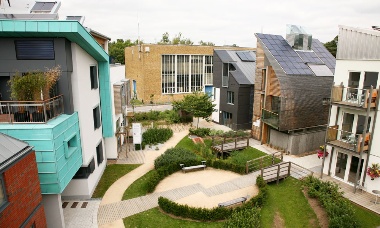Some of the changes that can be expected in the next edition of Part L of the Building Regulations have been announced at a launch event hosted by BRE in Watford.
At the event, it was confirmed that the minimum luminaire initial efficacy will be increased from 55 to 60 luminaire lumens per circuit watt and that the Lighting Energy Numeric Indicator (LENI) would be introduced as an alternate option for demonstrating compliance with lighting standards when the new regulations come into force in April 2014. The inclusion of LENI is no surprise and has been campaigned for by figures from across the industry. It has also been the subject of an extended campaign in Lighting.

BRE Watford Innovation Park
At the event, a series of presentations by civil servants and representatives from engineering firm AECOM, which has contributed to the new edition of the regulations, outlined the key changes to Part L 2014.
Anthony Burd head of technical policy at the Department of Communities and Local Government (DCLG) said Part L 2013 was an important 'technical' step, striking a balance between the moves towards zero carbon buildings in 2019 and the country's growth commitments.
As has been heavily signposted by DCLG, new homes would be expected to reduce their carbon emissions by six per cent across the building mix with a focus on fabric innovation, affordability and cost effectiveness. In an overview of the changes Paul Decort, technical policy officer with DCLG said further details would be set out in budget updates. The government announced in Dec 2012 that it would not be regulating for additional "consequential improvements", so that it didn't impose additional regulations on "hard-working consumers".
Decort went on to say there would be nine per cent aggregate CO2 target uplift in the non-domestic market, but with elemental backstops. He said the variability of the non-domestic build mix did not lend itself to introduction of absolute or mandatory energy targets.
In a further presentation on the building service compliance guides, John Palmer from AECOM said unless specified otherwise, the new regulations would recommend that, where appropriate, building services are provided with controls that as a minimum correspond to Band C in BS EN 15232:2007 Energy performance of buildings, Impact of building automation, controls and building management. He also showed a table outlining the additional control factors to reflect the greater range of available control systems.
Palmer went on to explain how LENI would provide a second option for non-domestic lighting calculations and showed a table (table 44) outlining the energy thresholds for different scenarios. They showed how lighting energy consumption (in kWh per annum) should not exceed the limits specified in this table, which takes account of recommended illuminance values in BS EN 12464-1: 2011, Lighting of indoor workplaces.
DCLG's Paul Decort said the impact assessment of the regulations had estimated that the changes would add £34 million of additional costs to the new build construction industry and £64million to the cost of all non-domestic buildings. But for the latter it estimated £92 million of business benefits. For existing non-domestic buildings it estimated £22 million of additional costs and £44 million of business benefits. He concluded by setting out a timetable for the changes (see box below).
When Lighting showed the presentations from the event to Peter Raynham from the Society of Light and Lighting he had the following to say: "They seem to be using the LENI idea and to adopt it pretty much as in the draft for public consultation.?The not so good bit is that the notional building in SBEM now assumes that the luminaires deliver 60 lumens/watt and there are presence and daylight controls.?My guess is that this means there is 20 per cent less energy available for lighting."
Iain Macrae head of global lighting applications at Thorn Lighting was more scathing in his interpretation of the slides from the launch event: "It's clear that the new Part L2 has emerged as some sort of mess. We expected an increase in efficiency, but [hoped this would be achieved] by encouraging lighting controls. The slides clearly show that the government still thinks more efficient luminaires are the cheapest way to decrease carbon rather than being prepared to maximise energy saving by seriously encouraging good luminaires and controls.
"We expected the 60 lumens/watt to be hidden in the depths of SBEM and a reduced form of LENI to be the preferred calculation method. This has been cut back to a tick box luminaire efficacy [approach] with hints that controls allow you to use less efficient luminaires. It looks like you can now comply by using an alternative calculation of LENI by ticking a box and entering a number (SBEM is still a mystery), and this will encourage controls, but it's easier and cheaper to use the first method for all.
"There is still a lack of clarity how to get a compliant building. The SBEM calculation has obviously not been significantly altered to work with LENI and hence may still be unfavourable to lighting. To me it will save some energy, but will not achieve what it could have done. It may lead to more dissatisfied customers as they are convinced to buy cheap luminaires with high LOR and reduced glare control just to [comply with] Part L and meet budgets."





